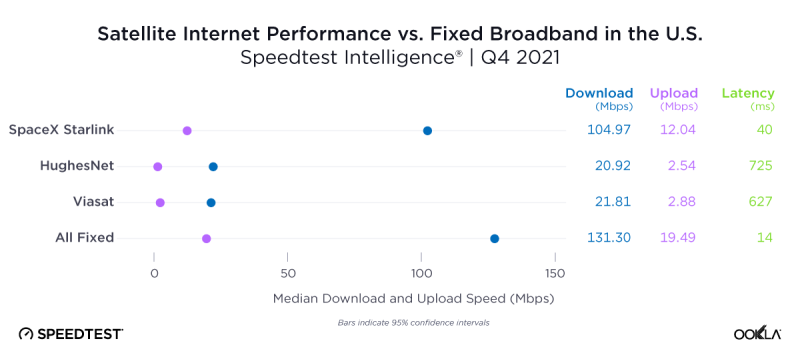SpaceX’s LEO satellite broadband service Starlink saw median download speeds improve in the U.S. in the fourth quarter of 2021 to reach above 100 Mbps, according to new data from Ookla.
Starlink represented the fastest U.S. satellite provider in Q4 Ookla reported, significantly outpacing HughesNet and Viasat on download and latency metrics.
Starlink’s median downloads improved since Q3 when Ookla reported 87.25 Mbps, to hit 104.97 Mbps in the last quarter of 2021.
It compares to Viasat with median downloads of just 21.81 Mbps and third placed HughesNet at 20.92 Mbps. SES was also added to the list but clocked just a mere 2.19 Mbps for downloads. Other than Starlink, none of satellite providers met FCC minimum thresholds of 25 Mbps down for broadband speeds.
And all fixed broadband combined still outpaced satellite, increasingly slightly from the third quarter to reach 131.30 Mbps in the median download category.
While Starlink saw download speed improvement, Ookla reported that uplink dropped slightly from 13.54 Mbps in Q3 to 12.02 Mbps in Q4. With LEOs located more closely to the ground, Starlink’s median latency score of 40 ms was much better than Viasat and HughesNet, which utilized higher geosynchronous earth orbit (GEO) satellites, and recorded 627 ms and 725 ms, respectively.
Still, performance by the Elon Musk-backed LEO broadband venture depends on where users were located – with speeds varying widely by county with around a 130 Mbps difference from fastest to slowest, according to Ookla. The test and measurement company reported Starlink’s fastest median download speed in Miami Dade County, Florida (191.08 Mbps) and its slowest in Columbia County Oregon (64.95 Mbps).

However, it isn’t just the U.S. where Starlink is improving. The company, which aims to provide connectivity across the globe to under- and unserved areas in hard-to-reach locations, recorded median download speeds above 100 Mbps in 15 countries, according to Ookla. Those include Australia, Austria, Canada, Chile, France, Germany, Ireland, Mexico, Netherlands, New Zealand, Poland, Portugal, the U.K. and the U.S.
In early February Starlink lost a batch of up to 40 satellites shortly after launch when they were hit by a solar storm. That event came shortly after the internet provider announced the introduction of a higher-cost premium tier promising faster speeds and increased throughput. The new tier promises speeds between 150-500 Mbps, compared to 100-200 Mbps for its regular service. That comes with a higher price tag though with a $2,500 one-time hardware fee and $500 per month for service - compared to the basic Starlink service, which costs just under $100 per month for service and around $500 for hardware.
Starlink’s service has also been playing a role in connecting Ukraine following Russia’s invasion of the country. This past Sunday, March 13, the Starlink software app was the most downloaded app from the Apple App store in Ukraine, according to the Wall Street Journal, which observed data from app analytics firm Sensor Tower. The report said Starlink’s app had around 21,000 installs globally on Sunday – the most in a single day, on both Apple and the Google Play store – the majority of which came from war-torn Ukraine, according to WSJ.
In late February Ukraine’s minister of digital transformation Mykhailo Fedorov had urged Elon Musk via Twitter to provide Ukraine with Starlink stations in late February, which Musk replied to the same day saying “Starlink service is now active in Ukraine. More terminals en route.”